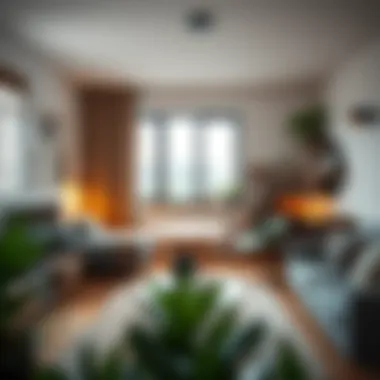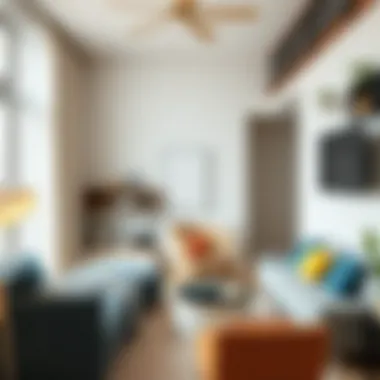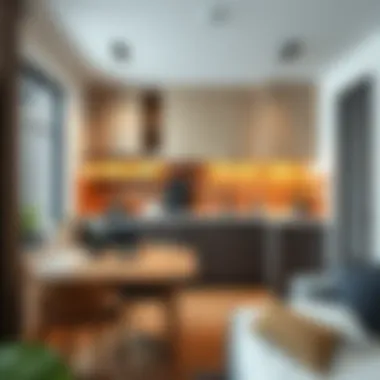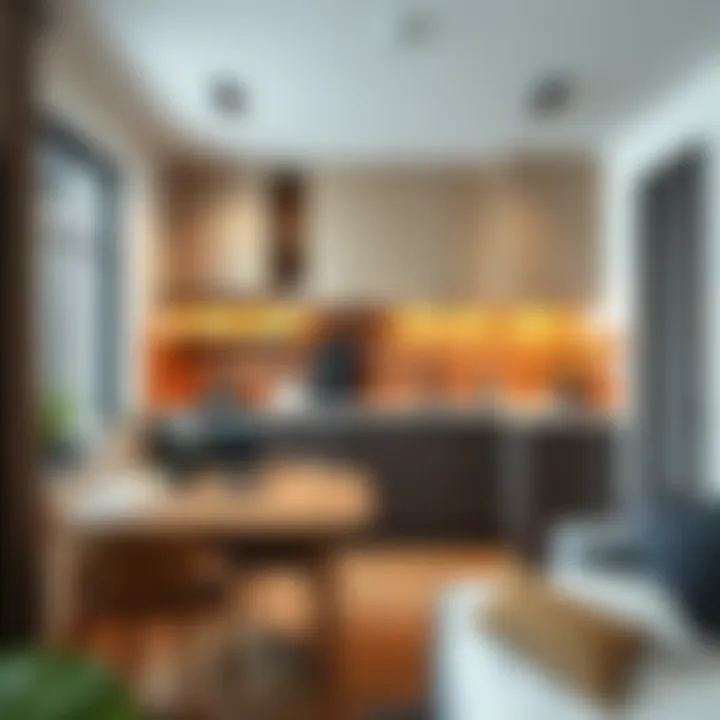Understanding Studio Apartments: Design and Benefits


Intro
The landscape of urban living has been increasingly redefined by studio apartments, small yet compelling spaces that cater to the needs of modern lifestyles. With their open-concept layouts and adaptable functionalities, studio apartments serve as a canvas for creativity and efficiency. Understanding the intricate details that come with these dwellings can be pivotal for anyone involved in real estate, interior design, or simply those looking to make informed housing choices.
This article will navigate through the defining characteristics and benefits of studio apartments. It aims to illuminate unique design ideas that maximize the potential of these spaces while addressing the challenges they present. Whether you are an architecture enthusiast looking for inspiration, a homebuyer weighing options, or an interior designer seeking fresh concepts, this guide provides valuable insights into the world of studio apartments.
Let’s embark on this exploration, peeling back the layers that make studio apartments desirable in today’s fast-paced urban environment.
Defining Studio Apartments
The concept of studio apartments has become increasingly prominent in contemporary urban living. Understanding what constitutes a studio apartment is essential for anyone interested in real estate, interior design, or even urban lifestyle.
Basic Concept
A studio apartment is essentially a self-contained living space that combines multiple areas—primarily a living room, bedroom, and cooking space—into a single room. The bathroom is usually separate but occupies a compact footprint. When you step into a studio, you immediately notice the open layout, which fosters both flexibility and intimacy.
The design quirk lies in its efficiency; the absence of walls allows for fluid movement and multipurpose use. Instead of compartmentalized square footage, residents learn how to utilize every nook and cranny. For instance, your bed could double as a sofa with a few throw pillows tossed on top. This compact living solution is particularly appealing to first-time renters and those wanting to downsize without sacrificing comforts.
Historical Context
Studio apartments began appearing in cities like Paris and New York in the early 20th century, reflecting a significant shift in urban living patterns. The demand for affordable housing drove the architectural evolution toward smaller, budget-friendly spaces. The idea was to create a living arrangement that catered to individuals or couples seeking proximity to bustling city life without the high costs associated with larger apartments.
Over the years, these apartments have transformed from mere makeshift solutions into stylish, well-designed living spaces that embody modern minimalism. The concept has continuously evolved with various design movements, from the simplicity of Bauhaus to the chic eclecticism of contemporary urban aesthetics, emphasizing that less can indeed be more.
Differences from Other Apartment Types
When comparing studios to other apartment types, the distinctions become clear. Unlike one-bedroom apartments, which segregate the sleeping area from the living space, studios embrace an open plan. This layout can feel more communal and inviting but might sacrifice privacy.
Another notable difference is in size; studio apartments often range from 300 to 600 square feet. In contrast, one-bedroom units typically offer more square footage, often starting at around 600 square feet at minimum. The trade-off? Affordability and location. Studio apartments usually come at a lower price point within desirable urban areas, making them attractive for those willing to compromise on square footage for a prime location.
In summary, defining a studio apartment encompasses its compact design, historical evolution, and distinct differences from other living arrangements. As the world moves toward smaller, more sustainable living choices, these definitions become even more relevant in guiding potential renters or owners toward informed decisions.
Key Features of Studio Apartments
Studio apartments represent a unique blend of style and functionality, which is crucial for maximizing the limited space they offer. Understanding the key features of studio apartments allows prospective tenants and designers to appreciate the charm these compact dwellings hold. Emphasizing the distinct characteristics such as an open floor plan, compact living space, and the use of multi-functional furniture can shed light on how to live comfortably and elegantly in a smaller footprint.
Open Floor Plan
One of the most defining features of studio apartments is the open floor plan. This design eliminates the traditional barriers between living spaces, merging the kitchen, living room, and bedroom into a single, cohesive area. The openness fosters a sense of spaciousness that can be quite refreshing in urban environments.
Additionally, the open layout allows for natural light to flow freely, creating a warm and inviting atmosphere. By keeping the space uncluttered, residents can use creative decor and layout strategies to enhance the feeling of expansiveness.
Some tips for maximizing an open floor plan include:
- Positioning furniture strategically: Placing larger pieces against the walls can open up walking paths.
- Using rugs: Different areas can be defined with rugs, providing depth and separation without the need for physical barriers.
- Incorporating light colors: Light hues help reflect light and enhance the airy nature of the space.
In essence, the open floor plan is pivotal in shaping the studio living experience, promoting versatility and a minimalist lifestyle.
Compact Living Space
The compact nature of studio apartments demands intentionality in design and organization. With limited square footage, every inch counts. This can be a challenge, but it also presents an opportunity to innovate. The compact living space encourages residents to prioritize their needs and eliminate unnecessary items, fostering a simpler lifestyle.
Moreover, the constraints of space can lead to a more thoughtfully curated environment. When space is at a premium, residents often find themselves investing in quality over quantity. This could mean selecting a few key pieces of furniture that not only fit well into the room but also serve multiple functions.
Consider these aspects when managing a compact space:
- Vertical space utilization: Install shelves and cabinets high up to maximize storage without crowding floor space.
- Minimal decorative items: Choose decor that speaks to individual style without overwhelming the senses.
- Flexible layouts: Assess how furniture can be rearranged for different needs, such as hosting a guest or working from home.
Thus, embracing the compact living space allows for creativity to thrive while fulfilling practical requirements.
Multi-Functional Furniture
Multi-functional furniture serves as the backbone of studio apartment living, enabling residents to make the most of their limited space. This type of furniture can transform from one use to another, adapting to the needs of the moment.
For example, a sofa bed can comfortably serve as a couch during the day and convert into a bed at night, making it ideal for entertaining and hosting guests. Another example might be a coffee table with storage beneath the surface, allowing for easy access to essentials like books or games without cluttering the space.
Here are some popular multi-functional furniture options to consider:


- Murphy beds: These beds fold up into the wall, freeing up floor space when not in use.
- Extendable dining tables: Great for small gatherings, they can be expanded when needed and reduced when not.
- Storage ottomans: They provide a seat and storage space all in one, perfect for storing miscellaneous items.
Incorporating multi-functional furniture not only enhances functionality but also supports a sleek and organized aesthetic in studio apartments.
"In a studio apartment, every piece of furniture tells a story; it has to serve various roles while maintaining style."
By understanding and implementing these key features, residents of studio apartments can navigate the challenges of small living spaces with creativity and sophistication. Each element—from the open floor plan to thoughtful furniture choices—contributes to a vibrant and functional home.
Benefits of Living in a Studio Apartment
Living in a studio apartment comes with a diverse range of benefits. Especially in today's fast-paced urban environment, these compact living spaces cater to various lifestyles, allowing residents to experience both affordability and comfort without compromising too much on quality of life. It is essential to shed light on the critical elements that make studio apartments an attractive option for many.
Affordability
One of the foremost advantages of choosing a studio apartment is affordability. In many cities, the cost of renting or buying a studio is significantly lower than that of larger apartments. This offers a golden opportunity for young professionals or students trying to establish themselves without plunging into the deep end of financial obligation. Think about it: instead of spending your paycheck on a sprawling two-bedroom unit, you can invest that money elsewhere or enjoy a richer lifestyle experience.
- Renting costs are often reduced, making living in vibrant urban areas more accessible.
- Utility bills usually shrink too, given the smaller space demands less heating or cooling, which can be a blessing for the wallet.
- In some instances, homeownership of a studio could lead to building equity at a fraction of the costs associated with more extensive properties.
It's easy to overlook, but these potential savings contribute to a greater sense of financial freedom, allowing you to focus resources elsewhere, be it travel, hobbies, or savings.
Location Advantages
Another significant perk is the location advantages that often accompany studio apartments. Urban centers generally boast a wide array of amenities and conveniences that come with living large in a compact space. In many cases, prospective renters or buyers find studio apartments favorably situated in close proximity to public transportation, shopping, and entertainment.
Key location benefits include:
- Access to public transit options, meaning you can easily commute to workplaces or explore the city without the need for a car.
- Proximity to cafes, restaurants, and parks can help cultivate a vibrant social life, which is even more attractive in smaller living areas.
- Living downtown or near trendy neighborhoods adds an air of excitement and convenience that makes daily living easier and more enjoyable.
Not only does this enhance your living experience, but it also heightens the feeling of community, which can often be missing in larger suburban settings.
Low Maintenance
Living in a smaller space comes with the added benefit of lower maintenance requirements. For many, the idea of cleaning a multi-bedroom apartment can be overwhelming. Studio apartments, however, tend to demand less upkeep. When you think about it, keeping things tidy and organized becomes a walk in the park.
With reduced surface areas to clean and fewer rooms to maintain, residents can spend time doing what they love instead of worrying about the dust and clutter.
- Fewer cleaning supplies are needed, which can reduce costs.
- There’s less potential for clutter to build up if you practice minimalism, leading to a more serene living environment.
- Maintenance issues are often easier to manage; if something needs fixing, it likely won’t take long to address since most problems are isolated to a single room.
Ultimately, ease of maintenance allows more time to enjoy life rather than being bogged down with chores and worries.
"The simplicity of studio living translates to a lifestyle filled with opportunity, flexibility, and enjoyment."
Challenges of Studio Living
Studio apartments come with their own set of trials and tribulations, which can be just as crucial to understand as their benefits. While they offer unique opportunities for space and creativity, living in a limited area necessitates adapting to a smaller and more simplified lifestyle. Knowing the challenges can help potential residents effectively navigate their studio living experience, emphasizing adaptability and foresight in their planning.
Limited Space
One of the most significant challenges of studio living is the limitation on physical space. Unlike larger apartments, studios often do not allow for the generous separation of spaces. An open floor plan may appear charming, but in practice, it can feel quite constricting for daily routines. Here are a few considerations regarding limited space in studio apartments:
- Lifestyle Adjustments: It may require a shift in mindset. Residents often need to prioritize their belongings and decide what is essential and what can be left behind. The idea of "less is more" becomes essential to creating a manageable living area.
- Furniture Choices: The type of furniture becomes uniquely crucial. Opting for multifunctional pieces, like a bed that converts to a couch or a table that doubles as a desk, is vital to maximize utility.
- Visual Design: Thoughtful arrangement of furnishings can create an illusion of more space. Techniques like keeping furniture close to the walls or using transparent materials can lighten the visual load in a studio.
Privacy Concerns
In a studio apartment, privacy may be a luxury that feels almost foreign. With everything situated in a single room, establishing boundaries can be challenging. Here are aspects to consider:
- Living Alone vs. Sharing: For individuals living alone, this concern might be trivial. However, for roommates, the lack of distinct sleeping and living areas may lead to conflicts regarding personal space and downtime. Sharing such intimate quarters necessitates clear communication and respect for each other’s needs.
- Noise Levels: Sound carries easily in open spaces, which can complicate relaxation and focus. Whether it's your roommate’s late-night antics or the street noise from outside, investing in soundproofing elements like curtains or soft furnishings might be needed.
Storage Issues
Insufficient storage stands as another hurdle in studio living. With limited room for belongings, getting creative with storage solutions becomes a must. Consider the following:
- Vertical Solutions: Utilizing vertical storage, such as shelves running up walls, can be a game-changer. This method keeps the floor space open while allowing for plenty of items to be stored away.
- Under-Furniture Space: A savvy way to store out-of-season clothes or lesser-used items is placing bins underneath beds or couches. Make the most of every nook and cranny.
- Decluttering Regularly: Keeping only what is necessary can help alleviate storage woes. Regularly examining belongings allows one to evaluate necessity, ensuring clutter stays minimal.
Understanding these challenges is the first step towards successfully navigating studio living. While drawbacks like limited space, privacy issues, and storage struggles might seem daunting, they offer a chance for residents to innovate and adapt, honing their problem-solving skills in the process. With the right mindset and solutions, these challenges can turn into opportunities for creating a uniquely satisfying home.
Design Ideas for Studio Apartments


Designing a studio apartment can feel like fitting a square peg in a round hole, especially because of the limited space. However, having a compact living area presents an opportunity to get creative. Thoughtfully chosen design ideas can make a studio functional and attractive. These ideas also allow you to express your personal style while ensuring that the living space is maximized for comfort and usability. Important elements to consider range from zoning to lighting and storage solutions. In the end, a well-designed studio doesn't just look good; it addresses the everyday needs and challenges of living in a small space.
Zoning the Space
Using Furniture as Dividers
Using furniture as dividers is a smart way to create distinct areas within a studio without the need for walls. By strategically placing sofas, bookshelves, or even tall plants, you can effectively carve out separate zones for sleeping, working, and lounging. This not only enhances privacy but also scales the comfort factor—each space can feel purposeful.
The key characteristic of this method is versatility. For instance, a tall bookcase not only provides division but also offers storage and decoration space. This is a popular choice among studio dwellers who want to maintain open visual lines while creating functional boundaries. However, the downside is that certain pieces can take up too much floor space, making the area feel cramped if not chosen wisely.
Color-Coding Areas
Color-coding areas is a vibrant way to define spaces within a studio—think bright throws for the sofa area and cooler tones for a workspace. The idea here revolves around using different colors to establish zones that can aid in the psychological separation of areas.
It's a beneficial choice for individuals who want an artistic approach to their layout. Implementing this can unify the look while clearly signaling boundaries. One potential downside might be that it requires a careful balancing act—too many colors can lead to visual chaos, draining the serene vibe of a limited space.
Creating Visual Breaks
Creating visual breaks is another effective way to maintain a sense of openness while delineating areas. Employing rugs to define a sitting area, hanging art at varying heights, or even adding different wall textures can create a dynamic aesthetic without closing off the space.
This approach promotes engagement, as the eye is drawn to various focal points rather than a monotonous expanse. The unique feature here lies in its simplicity: small changes yield significant effects. A drawback could be that, depending on the executed designs, too many breaks can confuse rather than clarify the flow of a studio layout.
Maximizing Natural Light
Natural light can work wonders in a studio apartment, making it feel more spacious and inviting. This characteristic is crucial, as a well-lit space often feels larger than it is. Smart placement of mirrors can reflect and amplify light, while sheer curtains can soften it without blocking it out. Keeping window areas unobstructed is also key. When the sun streams in, it lifts the mood and can turn a small, stuffy room into an airy sanctuary. However, it’s important to balance light with privacy, especially in urban settings.
Incorporating Vertical Storage Solutions
In a studio, floor space is at a premium. Hence, incorporating vertical storage solutions becomes not just a need, but a game changer. Wall-mounted shelves, hanging racks, and over-the-door hooks can turn often forgotten areas into functional storage hideaways. This helps keep clutter at bay, enabling the small space to feel more organized and breathable. Additionally, it encourages the use of the vertical space, allowing creativity in placement and design.
However, one must be cautious not to overload these vertical options, as they can also lead to a cluttered appearance if not managed correctly. A well-placed shelf can showcase personal items, but too many can create visual noise.
"Using smart design ideas in studio apartments can truly maximize their potential and make them a comfortable place to live."
Design ideas for studio apartments are not just about aesthetics; they solve practical issues while revealing style. By understanding and implementing these strategies, living in a compact area can transform from a challenge into an opportunity for innovation.
Choosing the Right Location
Choosing the right location can make or break your experience in a studio apartment. It’s not just about what’s on the inside; the external environment plays an equal, if not greater, role in determining your day-to-day satisfaction. Location influences everything from lifestyle convenience to personal safety. Therefore, understanding where to hang your hat that suits your needs is vital for a rewarding studio living experience.
One must take into account various elements when deliberating on the best locale for a studio apartment. Urban amenities, community culture, and the accessibility of essential services are paramount considerations. This section will delve into these aspects and highlight why each is pivotal for existing comfortably within a small space while also enjoying a vibrant lifestyle.
Urban Centers
Living in urban centers offers a plethora of advantages for studio residents. These hotspots are often bustling with vibrant life, providing an array of entertainment options, dining experiences, and cultural activities. Imagine stepping outside your door and finding a café where you can sip latte while soaking in the hustle and bustle, or perhaps walking down the street to catch an art exhibit or live music.
The density of urban centers means you can easily access public transportation, which makes commuting a breeze. Consider this: the less time you're stuck in traffic, the more time you get for yourself. Furthermore, reduced reliance on cars can lead to savings in expenses like fuel and parking. No doubt, this aspect can be a feather in your cap when living in a studio, where maximizing every inch of comfort matters.
Proximity to Amenities
Now, let’s talk about amenities — they're often viewed as the backbone of daily comfort. The closer you are to grocery stores, pharmacies, parks, and hospitals, the more hassle-free life becomes. This proximity becomes even more crucial in the tight confines of a studio, where every errand can feel monumental.
A few key amenities to consider include:
- Grocery Stores: Nothing beats having a market just a few minutes away for those spontaneous dinner plans.
- Laundry Facilities: If your studio doesn’t have in-unit laundry, being near a laundromat can save you a great deal of time and energy.
- Public Transport Hub: Easy access to buses or metros lowers the barrier for spontaneous trips or even the daily commute.
Ultimately, when choosing a place, remember that the right amenities can elevate a good living scenario into a stellar one. They provide that ease of living that makes a studio feel like home rather than just a small space.
Community Features
As you set your sights on a potential neighborhood, don’t forget about community features. Residents living in a strong community often mention the sense of security and belonging as a significant advantage. Shared public spaces, recreational facilities, and community events can be the glue that holds a neighborhood together.
A few key characteristics of a thriving community include:
- Safety: Living in a secure neighborhood can take a weight off your shoulders, allowing you to enjoy your studio more fully.
- Social Activities: Look for areas with community programs like movie nights, farmers' markets, or art walks. These events can foster connections and friendships with your neighbors.
- Diversity and Inclusion: Ultimately, a rich blend of backgrounds and perspectives can enhance your living experience, bringing various cultural experiences right to your doorstep.
Finding a location that offers not only a roof over your head but a community that you can be part of is key — it can make your studio not just a space, but a home.


In summary, choosing the right location for your studio apartment should be grounded in a comprehensive understanding of the urban landscape, proximity to essential amenities, and the community features that resonate with you. Take time to explore your options; it will be worth it in the end.
Sustainability and Studio Living
The concept of sustainability is gaining traction, particularly in urban settings where space is often at a premium. When it comes to studio apartments, sustainability intersects beautifully with their inherent characteristics. Not only do smaller spaces naturally foster a minimalist lifestyle, but they also present unique opportunities for eco-friendly choices that resonate with consumers today. Staying environmentally conscious within these compact dwellings can lead to both cost savings and a positive impact on our planet.
Eco-Friendly Design Choices
Making environmentally friendly choices in studio apartments does not have to be a daunting task. There is an array of design options that marry aesthetics with sustainability. Here are several key elements to consider:
- Use of Recycled Materials: A fantastic way to decrease the ecological footprint is through the selection of furniture and materials made from recycled components. Whether it’s reclaimed wood for furniture or recycled glass for countertops, these choices add character and sustainability to your living space.
- Sustainable Flooring Solutions: Opt for flooring made from bamboo or cork. Both options are renewable resources, and they add a warm, inviting touch to your studio. Bamboo, in particular, is a powerhouse of moisture resistance and durability.
- Non-Toxic Paints: Standard paints may contain harmful chemicals that contribute to indoor air pollution. Instead, choose low-VOC (volatile organic compounds) or eco-friendly paints that ensure your indoor air quality does not take a hit.
By incorporating these elements, you can cultivate a living environment that feels good while also being responsible.
Energy Efficiency in Small Spaces
When talking about sustainability in studio apartments, energy efficiency can’t be brushed aside. Smaller living spaces can leverage this concept to the fullest. Here are some practical approaches:
- Energy-Efficient Appliances: Investing in Energy Star-rated appliances may seem like a higher upfront cost, but the long-term savings on energy bills often make up for it. Smaller appliances suitable for studio apartments also use less energy compared to their full-sized counterparts.
- LED Lighting: Switching to LED light bulbs is an easy step toward energy efficiency. They consume less electricity and last significantly longer than traditional bulbs. Plus, they come in various designs to suit any aesthetic.
- Smart Home Technologies: Devices like smart thermostats can help control heating and cooling effectively. These technologies not only assist in energy management but can also provide insights on how to further reduce consumption.
With such strategies, studio dwellers can not only enjoy comfortable living but do so with a clear conscience. Embracing sustainability is about making informed decisions that contribute positively to the environment while enhancing the experience of living in a compact space.
"Creating an environmentally friendly home is about finding balance—not sacrificing comfort or style, but rather enhancing them."
In this regard, studio living becomes an inspiring model for modern lifestyles, promoting efficiency, conscious design, and a reduced ecological profile.
Real Estate Market Trends
The landscape of real estate constantly shifts and adapts to emerging societal preferences, economic conditions, and lifestyle choices. Understanding the real estate market trends that shape studio apartment availability and desirability is crucial for potential buyers, investors, and those simply interested in the housing market. With the rising urban population and changing demographics, couples, singles, and even small families are gravitating towards smaller living spaces, such as studio apartments.
Interest in Smaller Spaces
As cities become more congested and housing prices soar, there’s been a marked interest in smaller spaces. Studio apartments, with their efficient use of space, have emerged as a popular option for many, particularly young professionals and students. These apartments cater to a minimalist lifestyle, where less is often more. The desire for simplicity and lower upkeep is pushing people towards these compact homes. A recent survey indicated that over 60% of urban dwellers are considering living in a studio, showcasing the shifting preferences in housing.
The appeal also lies in the environment where these dwellings are typically located. Being in the heart of a bustling city, studios provide residents easy access to public transport, eateries, and cultural activities. Furthermore, minimal living can contribute to an overall reduction in environmental impact, aligning with growing sustainability trends.
- The compactness can lead to less energy consumption.
- Maintenance costs tend to be lower due to the size.
- A smaller home often means easier cleaning and upkeep.
Living in a studio can offer a vibrant community feel, as these spaces are often equipped in buildings that house multiple other residents who enjoy shared amenities.
"The notion of home is rapidly evolving from one defined by square footage to one defined by experiences and convenience."
Investment Potential
Studio apartments not only serve as living spaces, but they also possess significant investment potential. With the ongoing demand for affordable housing in urban centers, studios continue to demonstrate solid return on investment for landlords. They can typically be rented at competitive rates, often attracting a steady stream of tenants due to their affordability and convenience.
When examining the real estate investments landscape, there’s noteworthy data:
- Studio apartments can have a higher rental yield compared to larger units, making them appealing for real estate investors.
- Lower purchase prices result in a quicker turnover and easier entry into the market.
- They tend to have lower vacancy rates, as demand often outstrips supply in urban settings.
For prospective investors, understanding local trends is key. Areas that are undergoing revitalization or development may provide the best opportunities for purchasing studio properties. As cities continually evolve and adapt, studio apartments might just be a cornerstone of the urban fabric, representing both a home and a promising real estate endeavor.
In summary, keeping an eye on the trends surrounding studio apartments can not only enrich the living experience but also inform sound investment decisions in an ever-changing market.
Ending
In wrapping up our exploration of studio apartments, it’s clear that these unique living spaces hold a special place in urban design and the real estate market. Emphasizing affordability, location, and design ingenuity, studio apartments attract a diverse group of individuals ranging from young professionals to couples looking for a cozy home. The combination of simplicity and functionality makes them particularly appealing, especially as cities grow and space becomes a precious commodity.
Understanding studio apartments involves recognizing their key characteristics and the contexts they flourish in. The compactness urges inhabitants to embrace minimalist living, which often translates to lower costs and less maintenance. Moreover, with effective design strategies, even the smallest of spaces can blossom into a personal sanctuary that resonates with their occupant's lifestyle. Even though there are challenges, such as storage limitations and privacy concerns, they can be mitigated through creative solutions like multi-functional furniture and smart use of partitions.
Notably, the real estate market trend towards smaller spaces signals a shift in what potential buyers and renters prioritize. As cities evolve, the demand for such pragmatic designs is likely to grow, making studio apartments not simply a housing option but a strategic move in a dynamic urban environment.
Ultimately, as we move towards a more sustainable and efficient way of living, studio apartments can play a crucial role. They offer a glimpse into a future where less is more, and where thoughtful design can meet the needs of everyday life in a more profound way.
Summary of Key Points
- Definition and Characteristics: Studio apartments are characterized by their open layout, combining living, sleeping, and working spaces into one cohesive area.
- Advantages: The affordability, strategic location near amenities, and low maintenance requirements are main advantages of studio living.
- Challenges: While limited space and privacy can pose issues, they can be creatively addressed through innovative design approaches.
- Design Ideas: Effective zoning, maximizing natural light, and employing vertical storage are fundamental strategies to make the most of studio living.
- Market Trends: There is a growing interest in smaller living spaces, reflecting shifts in lifestyle choices and urban planning necessities.
Future Outlook for Studio Apartments
The future for studio apartments looks promising. As urban areas become more congested and housing prices trend upward, smaller living spaces will continue to gain traction.
- Urbanization Trends: With more individuals gravitating towards city life, studio apartments can be a manageable option against the high costs of larger homes.
- Sustainable Practices: The push for eco-friendly living will likely see studio apartments embracing green designs that optimize resources and reduce waste.
- Smart Technology Integration: Advancements in smart home technology will further enhance comfort and convenience within compact living spaces, making studio living more appealing.















